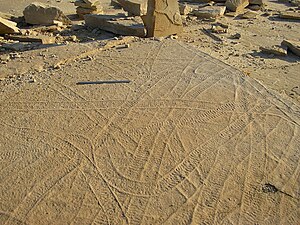Trace fossil

Trace fossils (or ichnofossils) are geological records of biological activity.[1] They are fossils, but not of the living things themselves. Probably the best-known examples are dinosaur trackways.
Trace fossils may be impressions made on the substrate by an organism. Burrows, borings,[2] footprints, feeding marks, and root cavities are examples. The term includes the remains of other organic material produced by an organism – for example, coprolites (fossilized droppings) or chemical markers. Stromatolites are sediment structures produced by bacteria. Trace fossils contrast with body fossils, which are the fossilized remains of parts of organisms' bodies, usually altered by later chemical activity or mineralization.
Structures which are not produced by the behaviour of an organism are not considered trace fossils.
The study of traces is called ichnology. Traces reflect the behaviour, not usually not the biological affinity of their makers. They are given their own names in taxonomy, based on their appearance and the implied behaviour of their makers.
Gallery
Thalassinoides, burrows produced by crustaceans, from the Middle Jurassic, southern Israel
Trypanites borings in the Ordovician from Kentucky. The borings are filled with diagenetic dolomite (yellowish). The boring on the far right cuts through a shell in the matrix.
Trace Fossil Media
The trackway Protichnites from the Cambrian, Blackberry Hill, central Wisconsin
Cross-section of mammoth footprints at The Mammoth Site, Hot Springs, South Dakota
This coprolite shows distinct top and bottom jaw bite marks, possibly from a prehistoric gar fish. Discovery location: South Carolina, US; age: Miocene; dimensions: 144.6 × 63.41 mm (5.693 × 2.496 in); weight: 558 g (1 lb 3.7 oz)
Eubrontes, a dinosaur footprint in the Lower Jurassic Moenave Formation at the St. George Dinosaur Discovery Site at Johnson Farm, southwestern Utah
Petroxestes borings in a hardground from the Upper Ordovician of southern Ohio
Related pages
References
- ↑ Seilacher A. 2007. Trace fossil analysis. Springer-Verlag. ISBN 9783540472254
- ↑ Bromley R.G. 1970. Borings as trace fossils and Entobia cretacea Portlock as an example. In: Crimes T.P. and Harper J.C. (eds) Trace fossils. Geological Journal Special Issue 3, 49-90.
